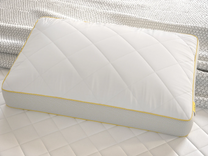Did you know the position you sleep in is just as important for your bones and squishy bits as what you sleep on? We asked sleep expert Dr Dave Gibson about the best sleeping positions, and why settling into bed the right way has so many benefits.
sleep like a baby
When we’re children, we naturally fall asleep in the position we find most comfortable, or most comforting. This often stays our preferred sleeping position all the way into adulthood. But does that mean it’s good for your sleep, or for your body?
What matters most is that your spine is correctly aligned. This not only helps to avoid back and neck aches, but can improve your digestion too.
assume the position
The reason we sleep is to help the body repair and rejuvenate itself, so it makes sense that the way we sleep can help to support different areas of the body.


side sleeping
Best for you if:
- You get back or neck aches. This position helps to get your shoulders and spine in neutral alignment.
- You’re pregnant. Doctors recommend lying on your left-hand side.
- You want to improve your digestion or you have digestive issues. Doctors also recommend lying on your left-hand side for this as it can improve gut mobility.

upright sleeping
Best for you if:
- You have back, hip or digestive issues. Being more upright and using supportive pillows takes pressure away from the abdomen and eases any uncomfortable bloating. It alsoavoids pressure on the shoulders and hips.Try putting a pillow under the knees and another under the small of your back to get your spine into neutral alignment.


front sleeping
Best for you if:
- Actually, I would avoid this position. It’s probably the worst for the body as it causes us to twist our neck. It’s even the most likely to cause wrinkles. Those with a history of lower back pain should really avoid lying in this position.
and the winner is…
Lying on your side is the most popular position for adults to sleep in, with 60% of us preferring this position. It’s probably the easiest position to stay comfortable in through the night as it allows us to move and fidget more freely when compared to lying on our backs.
Lying on your side is the easiest position to get your spine in neutral alignment too. I recommend finding a supportive pillow to place under your head and neck, and perhaps even another pillow between your knees to keep your pelvis in alignment. Side sleeping with your neck supported will also reduce heartburn and snoring.
practice makes perfect
Changing your sleep position takes a bit of patience, especially if you’re trying to fall asleep when you aren’t that tired. So always go to bed when you feel really sleepy rather than forcing yourself to lie there awake. It’s recommended that you get back out of bed if you don’t fall asleep within 20 minutes, and this should still apply when learning a new sleep position too.
Most experts would say it takes about 3 weeks to get used to a new position, and there are tricks to help you stop going back to your old position too. For example, if you’re going from a front sleeper to a side sleeper, prop pillows under your belly to stop you rolling over in the night. If you’re learning to sleep on your back, make sure you make it as comfortable as possible with pillows under your knees and back. You might need to elevate your head more to start with as well. Changing your mattress and pillow might be something to consider if you feel your new position isn’t properly supported by your existing bedding.







